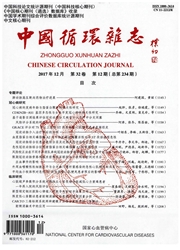

 中文摘要:
中文摘要:
目的:在大鼠心肌梗死模型上移植冠心病患者来源的骨髓间充质干细胞,探讨人骨髓间充质干细胞改善心肌梗死后心功能的作用机制。 方法:抽取冠心病患者骨髓,用人骨髓间质细胞专用培养液进行体外培养、扩增、标记。结扎大鼠冠状动脉左前降支制作心肌梗死模型,2周后使用超声筛选出合格的动物模型。然后动物随机分为细胞移植组(n=14)和培养液注射组(对照组,n=13)。在移植前后对心脏的收缩、舒张功能和心室重构指标进行超声评价和对比,取材后进行病理学检查和分子生物学检测。 结果:移植后进行超声评价,治疗组较对照组射血分数值和缩短分数值显著改善。免疫组化显示移植细胞在宿主体内可以向肌源性细胞分化。逆转录-聚合酶链反应(RT-PCR)显示细胞治疗组梗死区心肌Ⅰ型、Ⅲ型胶原基因表达水平明显高于对照组,而在非梗死区低于对照组。细胞治疗组梗死区间质细胞源因子、血管内皮生长因子、Bcl-2基因表达水平均明显高于对照组。 结论:冠心病患者骨髓间质细胞移植后可以提高心肌梗死后心脏收缩功能,减轻左心室重塑。作用机制可能为新血管生成增加、细胞外基质改变、旁分泌、抗凋亡和心肌再生等共同作用的结果。
 英文摘要:
英文摘要:
Objective:To discuss the mechanism of the heart functional improvement after transplantation of mesenchymal stem cells (MSCs) from patients with CAD in a rat model. Methods : Bone marrow was harvested from sternum of CAD patients, and then the MSCs were isolated, cultured and labeled. Two weeks after LAD ligation, the chosen rats were randomly divided into two groups : cell transplantation and control groups. At 4 weeks after injection, echocardiography was performed to assay the change of ventricular function and remodeling. The histological examination and reverse transcription-polymerase chain reaction (RT-PCR) analyses were also performed to identify and analyse the implanted cells. Results:Echocardiogram showed, both systolic heart function and the change of anterior wall thickening in transplantation group were significant higher than those in control group. By histochemical staining, continuous slices showed the labled cells could be stained positively for Desmin and Actin but negatively for cardiac specific troponin- Ⅰ . RT-PCR results indicated that the expressions of collagen Ⅰ , collagen Ⅲ, SDF-1, VEGF, Bcl-2 were much higher in the infarcted region in transplantation group and the expressions of collagen Ⅰ , collagen Ⅲ were much lower in the intact region in transplantation group. Conclusion:Human bone marrow mesenchymal stem cells can promote heart function and alleviate left ventricle remodeling when transplanted into rat infarted heart. The possible mechanisms may be involve with the increased generation of neovessles, the changes of extracellular matrix, paracrine effects, anti-apoptosis and myocardial regeneration.
 同期刊论文项目
同期刊论文项目
 同项目期刊论文
同项目期刊论文
 Overexpression of sorcin in multidrug resistant human leukemia cells and its role in regulating cell
Overexpression of sorcin in multidrug resistant human leukemia cells and its role in regulating cell Co-expression of cytokeratin 8 and breast cancer resistant protein indicates a multifactorial drug-r
Co-expression of cytokeratin 8 and breast cancer resistant protein indicates a multifactorial drug-r 期刊信息
期刊信息
